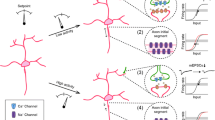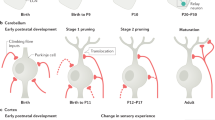Abstract
A number of neurodevelopmental disorders are caused by defects in activity dependent neuronal plasticity, the process by which neuronal activity shapes developing neuronal circuits. These disorders are caused by genetic mutations or other factors that disrupt intracellular signaling pathways that link the cell surface with the nuclear machinery for gene expression. The signaling pathways disrupted by these disorders are involved in learning, memory and behavior as well as in the synaptic proliferation and pruning that occurs during normal development. Examples of neurodevelopmental disorders that target plasticity include X-linked disorders such as Rett, Fragile-X and Coffin-Lowry Syndromes as well as acquired disorders such as cretinism.Several other X-linked mental retardation syndromes as well as autosomal disorders including neurofibromatosis type 1 and tuberous sclerosis also involve signaling pathways involved in neuronal plasticity. Disruption of neuronal plasticity is a mechanism that may underlie a diverse group of neurodevelopmental disorders.
Similar content being viewed by others
References
Chugani, HT. Metabolic imaging: a window on brain development and plasticity.The Neuroscientist 1999; 5: 29–40.
Penn AA, Shatz CJ. Brain waves and brain wiring: the role of endogenous and sensory-driven neural activity in development.Pediatr Res 1999; 45:447–458.
Deisseroth K, Bito H, Tsien RW. Signaling from synapse to nucleus: postsynaptic CREB phosphorylation during multiple forms of hippocampal synaptic plasticity.Neuron 1996; 16: 89–101.
Mayford M, Kandel ER. Genetic approaches to memory storage.Trends Genet 1999; 15:463–470.
Johnston MV, Harum KH. Recent progress in the neurology of learning: memory molecules in the developing brain.Dev and Behav Pediatrics 1999; 20:50–56.
Chelly, J. Breakthrough in molecular and cellular mechanisms underlying X-linked mental retardation.Hum Mol Genetics 8 :1833–1838.
Feng Y, Gutekunst CA, Eberhart DEet al. Fragile-X mental retardation protein: nucleocytoplasmic shuttling and association with somatodendritic ribosomes.J Neuroscience 1997; 17:159–47.
Irwin SA, Swain RA, Christmon, CAet al. Evidence for altered Fragile-X mental retardation protein expression in response to behavioral stimulation.Neurobiol Learn Mem 2000; 73: 87–93.
Weiler IJ, Greenough WT. Synaptic synthesis of the fragile X protein: possible involvement in synapse maturation and elimination.Am J Med Genet 1999; 83: 248–52.
Hall A. Rho GTPases and the actin cytoskeleton.Science 1998; 279:509–514.
Allen KM, Gleeson JG, Bagrodia Set al. PAK3 mutation in nonsyndromic X-linked mental retardation.Nat Genet 1998; 279: 509–514.
Gleeson JG, Allen KM, Fox JWet al. Doublecortin, a brain-specific gene mutated in human X-linked lissencephaly and double cortex syndrome, encodes a putative signaling protein.Cell 1998; 92: 63–72.
Silva AJ, Frankland PW, Marowitz Aet al. A mouse model for the learning and memory deficits associated with neurofibromatosis type 1.Nature Genetics 1997; 15:281–284.
Harum KH, Alemi L, Johnston MV. Cognitive impairment in Coffin-Lowry syndrome correlates with reduced RSK2 activation.Neurology 2001; 56: 207–214.
Petrij F, Giles RH, Danwerese HGet al. Rubinstein-Taybi syndrome caused by mutations in transcriptional co-activator CBP.Nature 1996; 376: 348–351.
Gibbons RJ, Picketts DJ, Higgs DR. Syndromal mental retardation due to mutations in a regulator of gene expression.Hum Mol Genet 1995; 4:1705–1709.
Lopes da Silva S, Burbach, JPH: The nuclear hormone receptor family in the brain: classics and orphans.Trends Neurosci 1995; 19: 542–548.
De Cesare D, Jacquot S, Hanauer Aet al. Rsk-2 activity is necessary for epidermal growth factor-induced phosphorylation of CREB protein and transcription of c-fos gene.Proc Natl Acad Sci USA 1998; 95:12202–12207.
Naidu S. Rett syndrome: a disorder affecting early brain development.Ann Neurol 1997; 42: 3–10.
Amir RE, Van den Veyver IB, Wan Met al. Rett syndrome is caused by mutations in X-linked MeCP2, encoding methyl-CpG-binding protein 2.Nat Genet 1999; 23:185–188.
Hamosh A, Johnston MV. Nonketotic hyperglycinemia. In Scriver, CR, Beaudet, AL, Sly, WSet al, eds.The Metabolic & Molecular Bases of Inherited Disease. New York McGraw-Hill, 2001:2065–2077.
Johnston MV, Goldstein GW. Selective vulnerability of the developing brain to lead.Curr Opin Neurol 1998; 11:689–693.
Author information
Authors and Affiliations
Corresponding author
Rights and permissions
About this article
Cite this article
Johnston, M.V. Developmental disorders of activity dependent neuronal plasticity. Indian J Pediatr 68, 423–426 (2001). https://doi.org/10.1007/BF02723021
Issue Date:
DOI: https://doi.org/10.1007/BF02723021




